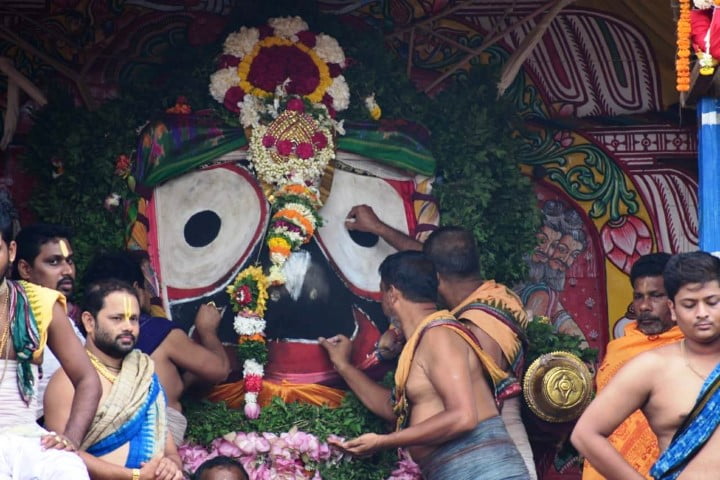Origin Of The Origin: Who Is Lord Jagannath!

The search started when someone asked me: “Who is Lord Jagannath and What is the origin?”. I believe that the research could only be at the surface as, every deep dive to unearth made one feel like he was still on the surface.
I was pitted against the infinite and the mystic, which I trust has created everything that we see and also which we don’t see. Hence, I have named this write-up as “Origin of the Origin”, which is a never-ending loop, which defies time and space and is unanalysable.
At this point, at the very gate of the infinite, I have to leave science. This is where science becomes mere “mortal” or perishable. It dies and the quest begins from here onwards.
Ado yaddaru plavate sindhoh pare apurusham, tadarabhasya durhano tena gacchaparastaram
“In the beginning, the primeval Lord manifested as the transcendental Daru Brahman on the shore of the Ocean, and those who go to take shelter in this Supreme Lord are sheltered from all difficulties.”
10th mandala (10.155.3) of the Rig Veda
Prior to being placed at the 12th century temple at Puri built by Choda Ganga Deva, Lord Jagannath was most probably worshipped on the seashore. (Sanskrit Scholar Murari Mishra has referred to this in a 9th Century play Anargharaghav Natakam (Reference: Orissa Historical Journal, Vol III, No I PP.9-10).
Lord Jagannath is MahaVishnu and the epic poet Sarala Das (of Pratarudradeva’s time) had described Lord Jagannath as an Avataree and not an Avatar. He is not an incarnation. So, he doesn’t have any life story or leelas or plays, as any other Avatar, like Rama and Krishna.
MahaVishnu is a form of address that signifies the high pedestal on which Lord Jagannath resides, easily the highest form of Vishnu. All avatars (incarnations) of Vishnu spring from Him.
In the Utkala Khanda of the Skanda Purana there is a question. “In which yuga or era did Indradyumna establish his kingdom at Purushottama kshetra?”
Kasminyuge sat u nripa indradyumnobhavanmune?
The answer says it all: (in Utkala Khanda)
Asit krutayugevipra indradyumnomahanrupaha Suryavamsesa dharmatmastasthu panchamapurusha
“During Satyayuga, there was a great king, Indradyumna, who possessed all the noble qualities of a Brahmana. He was born in Suryavamsa in the fifth generation from Brahma and was a very religious man.”
There are multiple versions of the origin of the Lord, but it is commonly accepted that in the first half of Brahma’s life (parardha), the Lord took the form of Nila Madhava and appeared in Sankha Kshetra (in this conch-shaped geography) in order to bless sinners of this world.
In the second parardha (the first Satya Yuga of the first Manvantara), a king named Indradyumna or Indrasavarni was born as the fifth descendent of Brahma and ruled over the land of Malava, making his capital in Avanti (now Ujjain).
Indradyumna is also known as Avanti Naresh. He was a great devotee of Vishnu and yearned to have the Lord’s audience (darshan), which fructified when on receiving information from an ascetic (rishi) called Jatila, he sent his brother Vidyapati on a mission to locate Nila Madhav (the blue Lord), whom Indradyumna wanted to worship.
Vidyapati located the Lord in tribal country, amid nature, worshipped by Visvavasu, and his tribal clan.
Interpretation: The meeting of Vidyapati and Visvavasu represents unique unity in diversity – Vidyapati representing the princely and Brahminical (he was the Rajguru) perspective and Visvavasu the tribal (people of nature) chief. The Lord’s worship and the temple proceedings are seamless, blending of two diverse cultures, that is the Brahminical Aryan tradition and the tribal Sabara cultures joined to form the unique tradition of the Vratyas.
The Daitas (believed to be from the tribal descendance and the Patis (from the Brahminical origin) form the principal set of servitors of the Lord, who exemplify non-dogmatic worship of the Lord – Lord belongs to everyone in the universe & beyond and not confined to any orthodoxy in worship or practices.
Vidyapati was overwhelmed after having the divine look (darshan) at the form of Nila Madhava, and had to return to Avanti, his kingdom, albeit against his wish of staying back with the Nila Madhava. Such was his devotion for Nila Madhava that as soon as Vidyapati left Purushottama kshetra, Nila (Indranilamani) Madhava and Rohini kunda vanished from their original places.
But Visvavasu had mentioned to Vidyapati that Nila Madhava would show up in a different form and he need not be saddened by the thought that he could no more have the divine vision of the Lord (Nila Madhava).
As per the Indranilamani Purana, Vidyapati narrated to Indradyumna his journey to and arrival in Purushottama kshetra, where he witnessed the presence of Devas (the other celestial Lords and angels) and their preparations for performing secret rituals for Nilamadhava.
Guided by Visvavasu, he went to the Rohini kunda, where he and Vidyapati took bath and meditated under the Kalpa Bata. After the Lord’s services were completed, the Devas returned to the heavens (Svargaloka) and Vidyapati on his return described Nila Madhava to Indradyumna, his brother, as “the Lord of the Universe, 81 angulas (fingers) tall and the divine figure standing on a golden lotus flower. So spellbound was Indradyumna on hearing this that he promised to shift his capital to Purushottama kshetra and dedicate his life to Lord Jagannatha.
He declared his wishes as:
Tatravasam karisyamipurvadurgani chaivahi, satopacharahe srinatham pujayishyedinedine
“There I will make my residence as I had already decided, and there I am going to perform perfect ritual worship to the Lord every day.”
……to be continued
(This is part one of the three-part series)
Disclaimer: The opinions expressed in this report are those of the author. They do not purport to reflect the opinions or views of the website

Comments are closed.